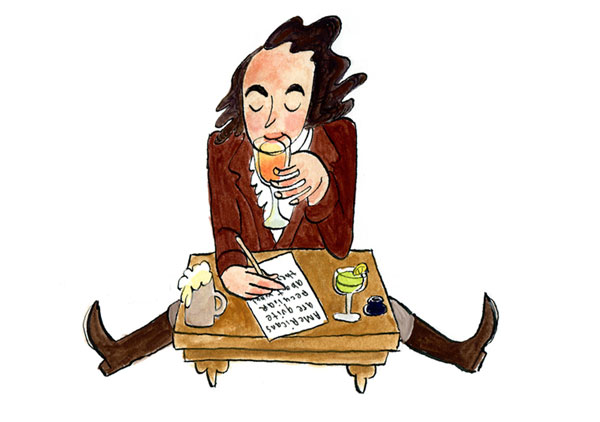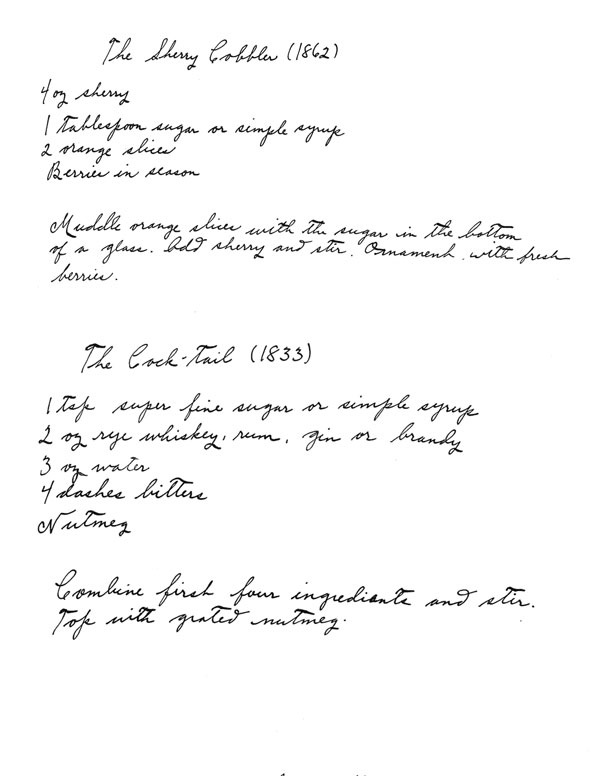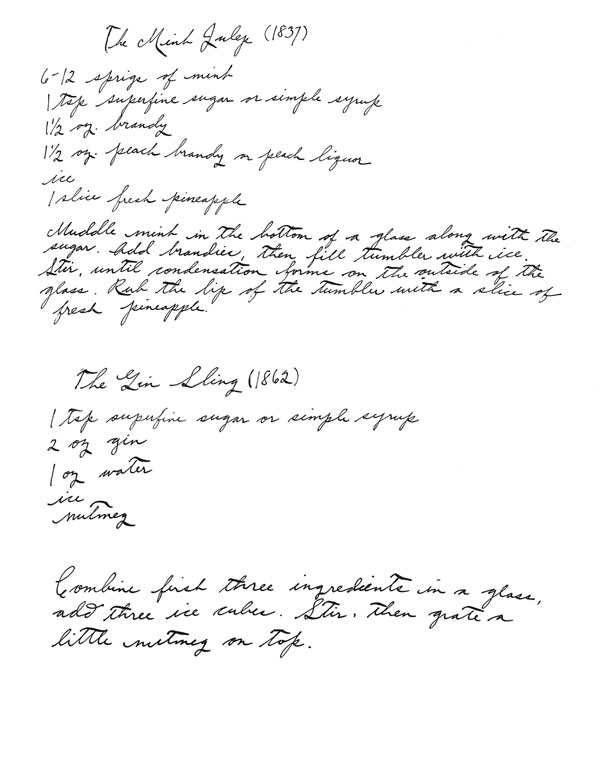 Oh, Dickens! Always boozing. Illustration by Peter Van Hyning.
Oh, Dickens! Always boozing. Illustration by Peter Van Hyning.
When Charles Dickens made his first trip to America in 1842 (recorded in American Notes for General Circulation), he made certain to partake of one of the greatest American inventions: the cocktail. Â While visiting Boston, he said “the bar is a large room with a stone floor, and there people stand and smoke, and lounge about, all the evening dropping in and out as the humor takes them. Â There too the stranger is initiated into the mysteries of Gin-sling, Cocktail, Sangaree, Mint Julep, Sherry-cobbler, Timber Doodle, and other rare drinks.”
Dickens didn’t write down any recipes for these “rare drinks”, but fortunately some of his contemporaries did.  Captain Alexander, who toured America in 1833, recorded the directions for making The Cock Tail, along with four other drinks he had at the City Hotel in New York, prepared by a celebrity bartender named Willard.  Another English tourist, Captain Marryat, recorded his experiences with Mint Juleps after he made a trip to America in 1837.   He said: “I once overheard two ladies talking in the next room to me, and one of them said, ‘Well if I have a weakness for any one thing, it is for a mint julep!’–a very amiable weakness, and proving her good sense and good taste. They are, in fact, like the American ladies, irresistible.”  I think that quote is like the best thing ever.
Much of what we know about Victorian cocktails comes from How to Mix Drinks; or, the Bon-Vivants Companion by Prof. Jerry Thomas, published in 1862. Which, thanks to Google, is now online.
Couldn’t make it out to What Dickens Drank at apex art last week? Â No worries; below, all the recipes you need to mix an 1840s cocktail at home. Â Photos from the event, and more, can be found here.



Most excellent article, Sarah… I love the recipes… i have such a fondness for the old cocktail books! Judging from the glasses, they were much smaller then! Don’t you love the nutmeg with gin? Who’d a thunk it? Sangaree is an English bastardization of sangria, but what on earth is a Timber Doodle???
A timber doodle seems to have been lost to time; no one knows. There are quite a few pre-phohibition drinks that no one wrote down, and no one knows how to make anymore! it’s too bad.
and I do love nutmed with gin, and I didn’t have any idea it would be so good!!
Historically speaking, what Dickens himself drank may be of less importance than the effect his writings had on what other people drank. This entry from “The Devil’s Food Dictionary: A Pioneering Culinary Reference Work Consisting Entirely of Lies” (Frogchart Press, 2009) addresses the issue:
“SYLLABUB: An archaic concoction of milk, sugar, spices, and wine or ale that makes frequent appearances in the works of Charles Dickens (1812–1870). Not a single batch of this supposedly festive beverage has been made in the last 100 years, and no living human being has ever tasted it. Indeed, as with so many
products of the Victorian culinary imagination, one wonders who would even want to. An even deeper question arises concerning syllabub, however: Is it possible that it never existed at all, but sprang wholly from Dickens’s rich imagination? More than one scholar has expressed that opinion, and it is hard to deny that the drink’s absurd name (an obvious hybrid of ‘syllogism’ and ‘Beelzebub’) is in keeping with Dickens’s wry style. All this leaves only one convincing explanation for syllabub’s continuing presence in culinary
dictionaries, namely, that food-related words beginning with certain unusual letter combinations (‘za’atar,’ for instance) are so scarce that dictionary compilers cannot afford to pass them up.”
I do have early recipes for “syllabubs.” like this one, from 1796: http://digital.lib.msu.edu/projects/cookbooks/display.cfm?TitleNo=1&PageNum=31 so there does seem to be some real world inspiration…
I have no idea whether the syllabub was real, and I understand the tone of the DFD is tongue-in-cheek, but I’d still point out that the description (‘milk, sugar, spices, and wine or ale’) applies to any number of decidedly real drinks from the era. If Dickens was making a joke, it may have been about how silly cocktail naming conventions often were; the drink itself, as described, was not unusual.
If they contained eggs, they were called ‘flips’ and were the first mixed drinks that constituted a popular phenomenon. The term changed meaning continuously depending on when and where it was used, but they originally were made hot and used eggs and/or cream to produce a thick froth. They predate the term cocktail and are the ancestor of contemporary eggnog and the Tom and Jerry. Made cold, wine-based flips require an alarming amount of shaking to prevent separation — and, like anything written down, they never entirely disappeared, though they’d already fallen out of favor by Prohibition. I highly recommend trying a port or sherry flip!
Love your site and the historic info. I have a reprint of the first published cookbook of Scotland 1736 and it has 2 syllabub receipts. They were intended as a dessert, being approximately half cream or whipped cream and fortified wine of some kind. The terminology is a bit hard to sus out for me as I am not Scottish and do not know some of the local words which may be not in use any more at any rate. All old Scots measures ( the intro has a conversion chart and glossery)
source:
Mrs McLintock’s Receipts for Cookery and Pastry-Work
Introduction & glossary by Iseabell Mcleod
publisher: AUP
Recipe # XLVII to make an eating syllabub
Take a pint of white or claret wine, and as much sweet cream, and skink (old scots word for pour) it in the Wine, put Sugar and Cinnamon on the top of it,and so eat it.
The second one even suggests to let the liquid drain off before serving.
There are a number of dishes describing how to make curds or “sprats” and I assume these are variants on that idea. Just about the only thing we have here like it is sabayon without the egg yolk added.
Recipe # XLVIII another syllabub
Take 3 Muchkins of sweet Cream, whisk it add Sugar, and the White of an Egg; then take eight or nine syllabub Glasses, fill them half full of sack and claret, sweeten them with Sugar, then put on your Snow that ye have whisked off the Cream, till ye fill up all your Glasses with the Snow; put the snow on the Drainer and let the Milk drain from it, before you put it in the glasses, and serve it up.
Just an opinion of mine but I tend not to listen to critics when it comes to food as I often like things the critics don’t, and that is where I place the quote that states this dish never existed by early writers as they knew perfectly well the effect of putting statements in writing on the reading public. In hopes of erasing the popularity of a dish they consider personally unpalatable. The first recipe title even distinguishes these as eating syllabub which leads one to believe there were other types.
Just my 2 cents worth. Hope you enjoyed them. :)
Out of curiosity, what is the Scottish cookbook called? My grandmother came from Glasgow, and I’m planning to one day get in touch my my Scottish culinary roots!
Mrs McLintock’s Receipts for Cookery and Pastry-Work
Introduction & glossary by Iseabell Mcleod
publisher: AUP
If you Google MacLeod Iseabail in amazon.com they have a used copy that won’t break the bank. I got mine in a gift shop while visiting the Vanderbilt home while on vacation years ago. its a small paperback. keep in mind these recipes are very old and probably not what you are used to. I really liked the chestnut pye, but the pot pies have the bones in so you might want to make some changes to those . Happy cooking and getting to know your roots.